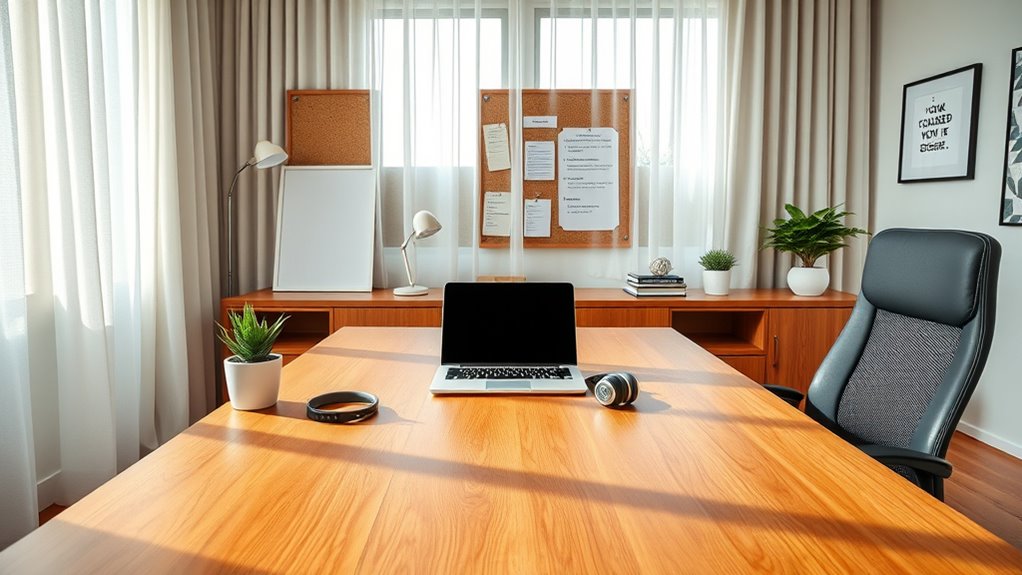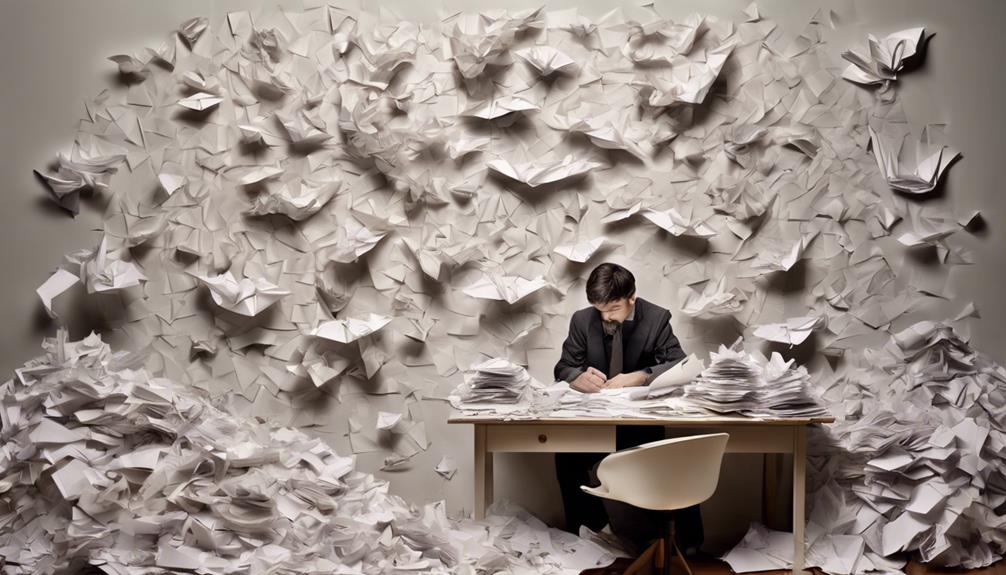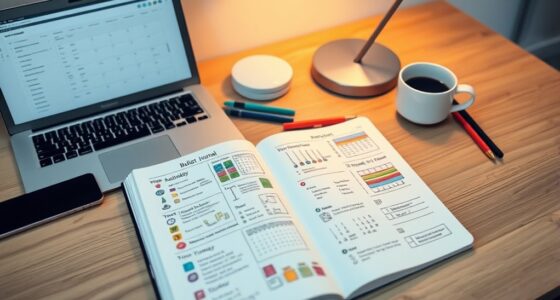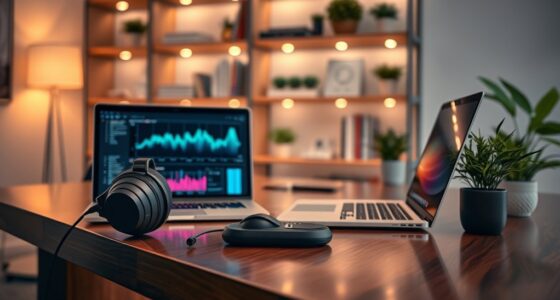To create a distraction-proof home workspace, minimize noise with soundproofing and noise-canceling headphones, and choose a quiet spot. Invest in ergonomic furniture that supports good posture, and keep your space organized with clutter-free surfaces and proper lighting to reduce visual stress. Add personal touches like decorations or tools to boost motivation. Combining these strategies helps you stay focused and productive; explore more ways to optimize your workspace here.
Key Takeaways
- Implement soundproofing solutions like acoustic panels and heavy curtains to minimize external noise distractions.
- Use ergonomic furniture with adjustable features to support comfort and reduce physical strain during work.
- Maintain a clutter-free workspace with proper lighting to enhance focus and decrease visual distractions.
- Personalize your space with decorative accessories or tools to boost motivation and create an inviting environment.
- Combine noise control, ergonomic setup, organization, and personalization for an effective distraction-proof workspace.

Creating a distraction-proof workspace at home is essential for maintaining focus and boosting productivity. When your environment minimizes interruptions, you can work more efficiently and feel less stressed. One of the most effective ways to achieve this is by prioritizing noise reduction. Noisy surroundings can break your concentration and make it difficult to stay engaged with your tasks. To combat this, consider investing in soundproofing solutions such as heavy curtains, acoustic panels, or weather stripping on doors and windows. Using noise-canceling headphones is also a great option for blocking out external sounds. If your home environment tends to be lively or noisy, these steps can create a calmer space that allows you to focus fully on your work.
Minimize distractions at home with soundproofing and noise-canceling headphones for better focus and productivity.
Alongside noise reduction, ergonomic furniture plays a crucial role in creating a distraction-proof workspace. When your furniture supports good posture and comfort, you naturally stay more engaged and less prone to discomfort that can distract you from your tasks. An ergonomic chair that offers proper lumbar support and adjustable height can prevent back pain and fatigue, keeping you alert throughout your workday. A desk at the right height ensures your wrists and arms are positioned comfortably, reducing strain and preventing discomfort that might otherwise pull your attention away. Positioning your monitor at eye level is equally important to avoid neck strain, which can become a persistent distraction over time. Incorporating ergonomic furniture can also influence your overall well-being and productivity during long hours of work.
Organizing your workspace with ergonomic furniture also means choosing a desk that provides enough space for your equipment without cluttering your area. Clutter itself is a common distraction, so selecting furniture that encourages tidy arrangements helps keep your workspace clean and focused. Additionally, incorporating adjustable features into your furniture allows you to customize your setup as needed, promoting better circulation and reducing physical discomfort. When you’re physically comfortable, your mind stays more engaged, and you’re less likely to be distracted by aches or repositioning. Incorporating proper lighting can also help reduce eye strain and improve concentration during long work sessions. Moreover, being aware of psychological factors, such as creating a positive and inviting environment, can further enhance your ability to stay focused and motivated.
Furthermore, adding elements such as crochet tools or decorative fabric accessories can personalize your space, making it more inviting and motivating. A well-designed environment fosters a positive mindset and encourages consistent focus. By creating a distraction-proof workspace that combines noise management, ergonomic comfort, organization, and personalization, you’re setting yourself up for sustained productivity and mental clarity. These elements work together to create a space where distractions are minimized, and your attention can remain on what truly matters—your work. When your environment supports your physical and mental comfort, you’ll find it easier to stay on task, complete projects efficiently, and enjoy a more satisfying work-from-home experience.
Frequently Asked Questions
How Can I Balance Work and Family Life in a Home Workspace?
Balancing work and family life at home requires setting clear family boundaries and practicing effective time management. You should establish specific work hours, communicate these boundaries to your family, and stick to them. Use a schedule to prioritize tasks and create dedicated workspaces to minimize distractions. By managing your time well and enforcing boundaries, you can stay productive while enjoying quality family time without feeling overwhelmed.
What Budget-Friendly Solutions Exist for Creating a Distraction-Proof Home Office?
Think of your home office as a fortress, and budget-friendly solutions are your shields. You can create DIY decor to personalize your space and add soft furnishings like rugs or curtains for noise mitigation. Use simple, inexpensive items like bookshelves or plants to block distractions. These small changes help you stay focused without breaking the bank, turning your workspace into a sanctuary of productivity and peace.
How Do I Tailor My Workspace Design to Different Personality Types?
To tailor your workspace design to different personality types, focus on personality-based customization and workspace personalization. If you’re more introverted, create quiet zones with minimal distractions. For extroverts, incorporate social elements like collaborative spaces. Visual thinkers benefit from vibrant decor, while detail-oriented individuals prefer organized, clutter-free areas. By understanding your personality, you can optimize your workspace, boosting focus and comfort through intentional personalization that aligns with your unique work style.
What Technology Tools Can Help Minimize Home Workspace Distractions?
To minimize home workspace distractions, you can use technology tools like noise-canceling headphones to block out background noise and improve focus. Virtual collaboration platforms, such as Zoom or Slack, help you stay connected without constant interruptions. These tools create a more productive environment by reducing distractions, allowing you to concentrate on your tasks. Incorporating these technologies enhances your work experience, making it easier to stay engaged and efficient at home.
How Can I Maintain Motivation and Focus During Long Work Hours at Home?
To stay motivated and focused during long work hours at home, prioritize your comfort with ergonomic seating and make sure your space has good ambient lighting. Take regular breaks to stretch and reset your mind, and set clear goals for each session. Avoid distractions by turning off notifications and creating a dedicated workspace. These habits help you maintain energy, improve concentration, and make your workday more productive.
Conclusion
Creating a distraction-proof workspace at home is about more than just organization; it’s about reclaiming your focus and productivity. By setting boundaries and customizing your environment, you can turn your space into a sanctuary of concentration. Remember, even in a world that sometimes feels like a full-blown circus, your dedication can make all the difference. So, channel your inner hero and conquer distractions—your work and peace of mind depend on it.










